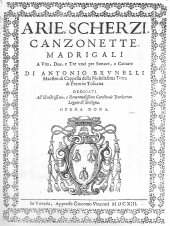Theoretician and composer of the beginning of the seventeenth century. «Alcuni di questi belli ingegni haverebbe potuto a prima vista supporre che questi miei concerti per la quantità e qualità de passaggi tornassero difficili a cantarsi, ma se v'applicheranno ben l'animo troveranno essere molto agevoli a quelli però che hanno regola e maniera di cantare, essendo così fatti componimenti già come tali messi in pratica da tutti i miei scolari, a contemplazione de' quali composi la maggior parte di essi» («Some of these wits may have thought that my concerts are difficult to sing because of the quantity and quality of some passages. But if they cudgel their brains, they will see that my concerts are very easy for all the people who master the manner of singing, because they are already performed by all my students, and I composed them just thinking of my students»). In these words, that the author addresses to the "kind readers" in the introduction to Fioretti Spirituali (1621), we can see the authentic significance of the artistic experience of Antonio Brunelli (S. Croce sull'Arno 1575 - Pisa 1630). These words represent the vivid dialectic with those persons - the "wits" - that thought about his music as difficult to be sung and they are a strong statement of the principle that constantly inspires his activities as a theoretician and a composer. The study and the daily concentration on a certain "manner of singing" that are requested to the "students" increase the possibility of excelling in the subject, and are rewarding for the performance of any repertory. The periods themselves of the training of Brunelli contribute to certify that aim - the learning and the transmission of good didactic praxis. This period is divided almost equally into the two geographical areas that testify of his presence: Lazio - in Bagnoregio, where his family moved, in Viterbo, probably under the guidance of the local composers, and in Rome, almost certainly in the last ten years of the sixteenth century, where he studied at the school of Giovanni Maria Nanino, one of the most important follower of the Palestrinian work - and Tuscany, his native land, where he performed as organist and as choir-master in San Miniato (1603-1607), Prato (1608-1612), and Pisa (from 1613), where he coordinated a big group of students in the church of Santo Stefano dei Cavalieri. The natural bent of Brunelli in facing a big variety of genres of the contemporary repertory is testified by his production - inclusive of two theoretic treatises -, which was published in a period of fifteen years - 1605-1621. These genres are correlated with those models of composition that most direct technical means and stylistic expression. The first cycle of works - which were published between 1605 and 1610, and then lost - certifies the attention to the didactic purpose (Esercizi a 2 voci, exercises for two voices), the approach to the polyphony of the sacred bicinia (two books of Mottetti a 2 voci) and the exordium in the profane repertory for two voices (music-hall and two books of Madrigals). The three collections of Aria, Scherzo, Madrigals, and Music-Hall for playing and singing with 1-3 voices and thorough bass, which were published in the period 1613-1616, are surely inspired to the monodic style. These collections confirm the interest for certain aspects of the didactic praxis - with the publishing in 1614 of Varii Esercizi a 1-2 voci, for the exercise of cornets, traverse and violins too - and show how Brunelli was a protagonist both in Pisa (with the musical entertainments conceived for the Grand Duke Cosimo I) and in Florence, where he fortified his friendship with Giulio Caccini and where he worked together with Jacopo Peri. The last cycle of his production is characterized by the return to the polyphony, which is enriched by the instrumental support - «cum gravi voce ad organo» - : the Sacra Cantica for 1-4 voices (1617), the Missae tres pro defunctis for 2-7 voices (1619) and the Fioretti spirituali for 1-5 voices (1621) - his fifteenth and last work, which stands to emphasize the continuity with the Prato di Sacri Fiori Musicali for 1-8 voices, that in 1612 started the author off on the interest for the orchestrated holy repertory. In order to qualify furthermore the work of Brunelli, we should mention all the persons he met in his artistic route: Giovanni Maria Nanino, his teacher during the training years; Biagio Pesciolini from Prato, who taught Brunelli the manners of the contrapuntal technique; Giulio Caccini who almost certainly was the responsible for the first assignment of Brunelli in Tuscany as an organist" precisely in San Miniato, from 1603 to 1608 - and who Brunelli itself thanked by dedicating his Canoni musicali sopra un soggetto solo (1612); Carlo Bocchineri, poet and member of the Accademia della Crusca - who helped Brunelli in working in Prato and who wrote seven of the texts that Brunelli used in the First and Second Book of Arie and Scherzi; «Balì» Ferdinando Saracinelli, from Orvieto, dignitary of the Medicean Court, who was the dedicatee of the Third Book of Arie and Scherzi, and author of «composed words [...] for the greater fortune and favour of my music». We should also mention those other protagonists of the contemporary music who were friends of or worked with Brunelli: Alfonso Fontanelli, who was the dedicatee of the Regole et dichiarationi (1610); the choreographer Agnolo Ricci, "inventor" of the Ballo della Cortesia (1614) - that was set to music by Brunelli and Jacopo Peri for a "party" that Michelangiolo Buonarroti il Giovane organized at Palazzo Pitti; Francesca Caccini, who inspired the beautiful mottetto O dulce nomen Iesu - dedicated to her in the Fioretti spirituali ; Artemisia Torri, who was the dedicatee of the Varii Esercizi - she was a singer of "great talent" and «uncommon ability», as Brunelli himself said; the famous Tuscan monodists Lorenzo Allegri and Vincenzo Calestani, who were included in the Second Book of Arie and Scherzi, with a musical excerpt for each. The contemporary testimonies and the valuable quotations that in the late seventeenth century are reserved to Brunelli - as in the Musico Prattico by Giovanni Maria Bononcini in 1673 - are strictly related to the recall of his theoretical work and his compositions that the historiography and the musical treatises of the eighteenth-nineteenth century. To certify this we can mention the reliable evidences of Sebastien de Brossard - in the Dictionnaire (1703), Giuseppe Ottavio Pitoni - in the Notitia (1725), Padre Martini - in the Esemplare (1774), Giuseppe Baini - in the Memorie (1828). Moreover, in the Dictionary of Tommaseo-Bellini (1865-1879), we can find Brunelli as one of the musical sources assumed as an useful model to confront the recurrence and the definitions of certain terminology. In the dictionary we can find the Regole utilissime - 1606, the first of his two treatises - together with the works of some important theorists of the sixteenth-seventeenth century as Aaron, Zarlino, Artusi, Agazzari, Antegnati, Zacconi, G. B. Doni. The contribution of Brunelli to "new compositions" is certainly debtor to the Roman school and the Florentine style - but also to a certain holy orchestrated repertory of a northern-Italian area, based on the models of Banchieri and Viadana. These "new compositions" were created - as Brunelli himself says to the reader - to «open the eyes and the minds in order to find any smallest imperfection into them, with subtleness». Piero Gargiulo
Vocal Music
Messa "Pro Defunctis", op. 14
Fioretti Spirituali (Prima Parte)
Arie, Scherzi, Canzonette e Madrigali, libro primo










